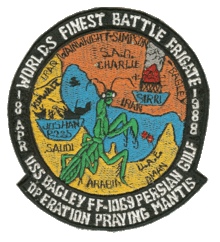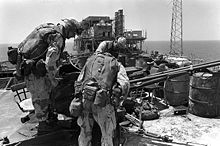- Operation Praying Mantis
-
Operation Praying Mantis Part of Iran-Iraq War 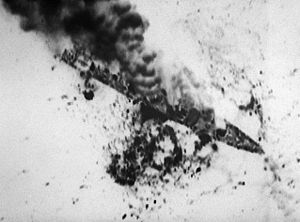
Iranian frigate IS Sahand (74) attacked by aircraft of U.S. Navy Carrier Air Wing 11 after the guided missile frigate USS Samuel B. Roberts struck an Iranian mineDate 18 April 1988 Location Persian Gulf Result U.S. Navy victory Belligerents  United States
United States Iran
IranStrength 1 aircraft carrier,
1 amphibious transport dock
4 destroyers
1 guided missile cruiser
3 frigates2 frigates
1 gunboat
6 Boghammar speedboats (estimated)
2 F-4 fighters
2 platformsCasualties and losses 1 helicopter crashed (2 Marines killed) 1 frigate sunk (45 crew killed[1])
1 gunboat sunk (11 crew killed[1])
3 speedboats sunk
1 frigate damaged
2 platforms damagedCited by United States Naval Academy Prof. Craig L. Symonds as being decisive in establishing U.S. naval superiority. Related U.S. operations in bold
Kaman 99 – Abadan – 1st Khorramshahr – Morvarid – Dezful – Undeniable Victory – 2nd Khorramshahr – Samen-ol-A'emeh – Jerusalem Way – Jerusalem – Ramadan – Before the Dawn – Dawn 1 – Dawn 2 – Dawn 3 – Dawn 4 – Dawn 5 – Dawn 6 – Marshes – Kheibar – Badr – Al-Anfal Campaign – 1st Al Faw – Dawn 8 – Karbala 4 – Karbala-5 – Karbala-6 – USS Stark Incident – Karbala Ten – Nasr 4 – Earnest Will – Prime Chance – Eager Glacier – Nimble Archer – Halabja – Zafar 7 – 2nd Al Faw – Praying Mantis – Air Flight 655 Incident – MersadOperation Praying Mantis was an attack on April 18, 1988, by U.S. naval forces within Iranian territorial waters in retaliation for the Iranian mining of the Persian Gulf during the Iran Iraq war and the subsequent damage to an American warship.
On 14 April, the guided missile frigate USS Samuel B. Roberts struck a mine while deployed in the Persian Gulf as part of Operation Earnest Will, the 1987–88 convoy missions in which U.S. warships escorted reflagged Kuwaiti oil tankers to protect them from Iranian attacks. The explosion opened a 25-foot hole in the Roberts's hull and nearly sank it. The crew saved their ship with no loss of life, and Roberts was towed to Dubai on 16 April. After the mining, U.S. Navy divers recovered other mines in the area. When the serial numbers were found to match those of mines seized along with the Iran Ajr the previous September, U.S. military officials planned a retaliatory operation against Iranian targets in the Persian Gulf.
The attack by the U.S. helped pressure Iran to agree to a ceasefire with Iraq later that summer, ending the eight-year conflict between the Persian Gulf neighbors.[2]
On November 6, 2003, the International Court of Justice ruled that "the actions of the United States of America against Iranian oil platforms on 19 October 1987 (Operation Nimble Archer) and 18 April 1988 (Operation Praying Mantis) cannot be justified as measures necessary to protect the essential security interests of the United States of America." The International court of justice also dismissed Iran's claim that the attack by United States Navy was a breach of the 1955 Treaty of Amity between the two countries.[3]
This battle was the largest of the five major U.S. surface engagements since the Second World War, which also include the Battle of Chumonchin Chan during the Korean War, the Gulf of Tonkin incident and the Battle of Dong Hoi during the Vietnam War, and the Action in the Gulf of Sidra in 1986. It also marked the U.S. Navy's first exchange of anti-ship missiles by ships.
Contents
The battle
On 18 April, the U.S. Navy attacked with several groups of surface warships, plus aircraft from the carrier USS Enterprise (CVN-65), and her ASW/AAW escort USS Truxtun (CGN-35). The action began with coordinated strikes by two surface groups.
One surface action group, or SAG, consisting of the destroyers USS Merrill (DD 976) and USS Lynde McCormick (DDG 8), plus the amphibious transport dock USS Trenton (LPD-14) and its embarked Marine Air Ground Task Force, was ordered to destroy the guns and other military facilities on the Sassan oil platform. At 8 am, the SAG commander, who was also the commander of Destroyer Squadron 9, ordered the Merrill to radio a warning to the occupants of the platform, telling them to abandon it. The SAG waited 20 minutes, then opened fire. The oil platform fired back with 8-barrelled 23mm ZSU-23 guns. The SAG's guns eventually disabled some of the ZSU-23s, and platform occupants radioed a request for a cease-fire. The SAG complied. After a tug carrying more personnel had cleared the area, the ships resumed exchanging fire with the remaining ZSU-23s, and ultimately disabled them. Cobra gunships completed the destruction of enemy resistance. The Marines boarded the platform, and recovered a single wounded survivor (who was transported to Bahrain), some small arms, and intelligence. The Marines planted explosives, left the platform, and set them off. The SAG was then ordered to proceed north to the Rakhsh oil platform to destroy it.
As the SAG departed the Sassan oil field, two Iranian F-4s made an attack run, but broke off when the Lynde McCormick locked its fire control radar on the aircraft. Halfway to the Rahksh oil platform, the attack was called off in an attempt to ease pressure on the Iranians and signal a desire for de-escalation.
The other group, which included guided missile cruiser Wainwright and frigates Simpson and Bagley, attacked the Sirri oil platform.
The SEALS were assigned to capture, occupy and destroy the Sirri platform but due to heavy pre-assault damage from Naval Gunfire, it was determined that an assault was not required.
Iran responded by dispatching Boghammar speedboats to attack various targets in the Persian Gulf, including the American-flagged supply ship Willy Tide, the Panamanian-flagged Scan Bay and the British tanker York Marine. All of these vessels were damaged in different degrees. After the attacks, A-6E Intruder aircraft from the VA-95 "Green Lizards" were directed to the speedboats by an American frigate. The two aircraft, piloted by Lieutenant Commander James Engler and Lieutenant Paul Webb, dropped Rockeye cluster bombs on the speedboats, sinking one and damaging several others, which then fled to the Iranian-controlled island of Abu Musa.[4]
Action continued to escalate. The Joshan, an Iranian Combattante II Kaman-class fast attack craft, challenged USS Wainwright (CG-28) and Surface Action Group Charlie. The commanding officer of USS Wainwright directed a final warning (of a series of warnings) stating that the Joshan was to "stop your engines, abandon ship, I intend to sink you". Joshan responded by firing a Harpoon missile at them.[5] The USS Simpson (FFG-56) responded to the challenge by firing two Standard missiles, while Wainwright followed with one Standard missile.[5] The attacks destroyed the Iranian ship's superstructure but did not immediately sink it, so USS Bagley (FF-1069) fired a Harpoon of its own; the missile did not find the target. SAG Charlie closed on the Joshan, with Simpson, then Bagley and Wainwright firing guns to sink the crippled Iranian ship.[5]
Two Iranian F-4 Phantom fighters then approached the Wainwright. One fighter left the area soon after the cruiser placed its 55B Fire Control Radar in search mode. The second fighter made a low-altitude approach towards the warship, which responded by firing two SM-2 missiles at the fighter. One hit the Iranian aircraft, blowing off part of its wing and peppering the fuselage with shrapnel. The Iranian pilot managed to land his damaged airplane at Bandar Abbas.[5]
Fighting continued when the Iranian frigate IS Sahand (F74) departed Bandar Abbas and challenged elements of an American surface group. The frigate was spotted by two VA-95 A-6Es while they were flying surface combat air patrol for USS Joseph Strauss (DDG-16).
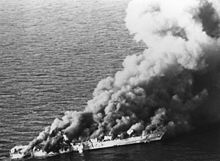 Iranian frigate IS Sahand (F74) burning from bow to stern on 18 April 1988 after being attacked.
Iranian frigate IS Sahand (F74) burning from bow to stern on 18 April 1988 after being attacked.
Sahand fired missiles at the A-6Es, and U.S. Intruders replied with two Harpoon missiles and four laser-guided Skipper bombs. USS Joseph Strauss fired a Harpoon. Most, if not all of the shots scored hits, causing heavy damage and fires. Fires blazing on Sahand's decks eventually reached her munitions magazines, causing an explosion that sank the vessel. Despite the loss of Sahand, one of Iran's most modern ships,[citation needed] the Iranian Navy continued to fight.
Late in the day, the Iranian frigate IS Sabalan (F73), departed from its berth and fired a surface-to-air missile at several A-6Es from VA-95. An A-6 then dropped a Mark 82 laser-guided bomb into the Sabalan's smokestack, crippling the ship and leaving it burning. The Iranian frigate, stern partially submerged, was taken in tow by an Iranian tug, and was repaired and returned to service. VA-95's aircraft, as ordered, did not continue the attack. The A-6 pilot who crippled the Sabalan was awarded the Distinguished Flying Cross by Admiral William J. Crowe, Chairman of the Joint Chiefs of Staff, for these actions against the Sabalan and the Iranian gunboats.[6]
Iran may have fired Silkworm missiles from land bases against SAG Delta in the Strait of Hormuz and against USS Gary (FFG-51) in the northern central Persian Gulf. U.S. officials, in their after-action report, said there was no evidence of this.[7] Lee Allen Zatarain in "Tanker War" presents evidence that Iran did launch missiles, which were engaged by the targeted U.S. Navy ships without damage.[citation needed]
Disengagement
Following the attack on the IS Sabalan, U.S. naval forces were ordered to assume a de-escalatory posture, giving Iran a way out and avoiding further combat. Iran took the offer and combat ceased, though both sides remained on alert, and near clashes occurred throughout the night and into the next day as the forces steamed within the Gulf. Two days after the battle, the USS Lynde McCormick (DDG 8) was directed to escort a U.S. oiler out through the Strait of Hormuz. (A Scandinavian flagged merchant remained near, probably for protection.) While the ships remained alert, no hostile indications were received, and the clash was over.
Aftermath
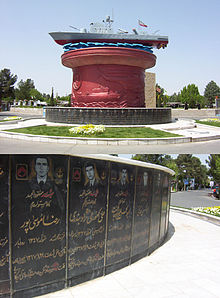 Memorial for Iranian sailors who died in Operation Praying Mantis at Behesht-e Zahra cemetery in Tehran
Memorial for Iranian sailors who died in Operation Praying Mantis at Behesht-e Zahra cemetery in Tehran
By the end of the operation, American ships and aircraft had damaged Iranian naval and intelligence facilities on two inoperable oil platforms in the Persian Gulf, and sunk at least three armed Iranian speedboats, one Iranian frigate and one fast attack gunboat. One other Iranian frigate was damaged in the battle.[8] Sabalan was repaired in 1989 and has since been upgraded, and is still in service with the Iranian navy. In short, Iran lost one major warship and a smaller gunboat. Damage to the oil platforms was eventually repaired and they are now back in service.
The U.S. side suffered two casualties: the aircrew of a Marine Corps AH-1T Sea Cobra helicopter gunship. The Cobra, attached to the USS Trenton, was flying reconnaissance from the Wainwright and crashed sometime after dark about 15 miles southwest of Abu Musa island. The bodies of Capt. Stephen C. Leslie, 30, of New Bern, N.C., and Capt. Kenneth W. Hill, 33, of Thomasville, N.C., were recovered by Navy divers in May, and the wreckage of the helicopter was raised later that month. Navy officials said it showed no sign of battle damage.[9]
The guided missile cruiser USS Vincennes was called to protect the extraction of the Roberts and arrived a month later. The heightened tensions contributed to the crew of the Vincennes shooting down a commercial airliner on a routine flight, Iran Air Flight 655, killing all 290 crew and passengers on 3 July, less than two months after their arrival. According to the U.S. government, the Iranian Airbus was mistakenly identified as an attacking military F-14 fighter. The Iranian government, however, maintains that the Vincennes knowingly shot down a civilian aircraft.
Operation Praying Mantis is one of five American naval engagements cited by United States Naval Academy Prof. Craig L. Symonds in his book Decision at Sea (2005) as being decisive in establishing U.S. naval superiority. The others were the Battle of Lake Erie (1813), the Battle of Hampton Roads (1862), the Battle of Manila Bay (1898), and the Battle of Midway (1942).
On 6 November 2003 the International Court of Justice dismissed Iran's claim for reparation against the United States for breach of the 1955 Treaty of Amity between the two countries. The court also dismissed a counterclaim by the United States, also for reparation for breach of the same treaty. The court ruled in favor of neither party, saying that "the actions of the United States of America against Iranian oil platforms on 19 October 1987 (Operation Nimble Archer) and 18 April 1988 (Operation Praying Mantis) cannot be justified as measures necessary to protect the essential security interests of the United States of America." The Court also ruled that it, "...cannot however uphold the submission of the Islamic Republic of Iran that those actions constitute a breach of the obligations of the United States of America under Article X, paragraph 1, of that Treaty, regarding freedom of commerce between the territories of the parties, and that, accordingly, the claim of the Islamic Republic of Iran for reparation also cannot be upheld;"[10]
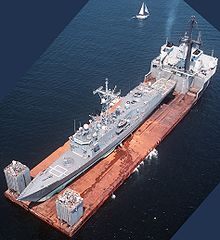 Samuel B. Roberts is carried away aboard the Mighty Servant 2 after hitting a mine in the Persian Gulf.
Samuel B. Roberts is carried away aboard the Mighty Servant 2 after hitting a mine in the Persian Gulf.
- Officer in Tactical Command: Commander Joint Task Force Middle East (aboard USS Coronado)[11]
- Battle Group Commander: Commander, Cruiser/Destroyer Group Three (aboard USS Enterprise)
Surface Action Group Bravo
- On Scene Commander: Commander, Destroyer Squadron Nine (Embarked on the Merrill)
- USS Merrill (DD-976) – destroyer
- USS Lynde McCormick (DDG-8) – guided missile destroyer
- USS Trenton (LPD-14) – amphibious transport dock
- Marine Air-Ground Task Force (MAGTF) 2–88 (4 AH-1T, 2 UH-1, 2 CH-46)
Surface Action Group Charlie
- OSC: CO, USS Wainwright
- USS Wainwright (DLG/CG-28) – guided missile cruiser
- USS Bagley (FF-1069) – frigate
- USS Simpson (FFG-56) – guided missile frigate
- SEAL platoon
Surface Action Group Delta
- OSC: Commander Destroyer Squadron Twenty Two (Embarked on the Jack Williams)
- USS Jack Williams (FFG-24) – guided missile frigate
- USS O'Brien (DD-975) – destroyer
- USS Joseph Strauss (DDG-16) – guided missile destroyer
Air support
- Elements of Carrier Air Wing Eleven operating from aircraft carrier USS Enterprise (CVN-65)
See also
References
- ^ a b Islamic Republic News Agency
- ^ Peniston, Bradley (2006). No Higher Honor: Saving the USS Samuel B. Roberts in the Persian Gulf. Annapolis: Naval Institute Press. ISBN 1-59114-661-5. http://www.navybook.com/nohigherhonor., p. 217.
- ^ International Court of Justice. Oil Platforms (Islamic Republic of Iran v. United States of America). Accessed 12 December 2006.
- ^ Palmer, Michael (2005). Command at sea: naval command and control since the sixteenth century. Harvard University Press, p. 310. ISBN 0674016815
- ^ a b c d U.S.-Iranian Military Clashes in the Persian Gulf in the 1980s The Inside Story by David B. Crist 13 July 2009
- ^ http://www.greenlizards.org/operation_praying_mantis/operation_praying_mantis.htm
- ^ "Gulf of Conflict: A History of U.S.-Iranian Confrontation at Sea", p. 10. David B. Crist, Policy Focus #95 | June 2009, Washington Institute for Near East Policy
- ^ Peniston, Bradley (2006). "No Higher Honor: Photos: Operation Praying Mantis". http://www.navybook.com/nohigherhonor/pic-prayingmantis.shtml. Retrieved 2 February 2009.
- ^ "Will Block Oil Traffic if Its Tankers Are Stopped: Iran;" Los Angeles Times Los Angeles, Calif.: 18 May 1988. pg. 7. In his recent book "Tanker War", author Lee Allen Zatarain indicates that there was some indication that they may have crashed evading hostile fire from the island.
- ^ International Court of Justice. Oil Platforms (Islamic Republic of Iran v. United States of America). Accessed 12 December 2006.
- ^ Proceedings, U.S. Naval Institute 66 (May 1989) © 1989 United States Naval Institute The Surface View: Operation Praying Mantis By Captain J. B. Perkins III, U.S. Navy, accessed via http://www.strategypage.com/militaryforums/8-8434/page3.aspx, 17 July 2008
External links
- Operation Praying Mantis photos: U.S. ships, assault on Sassan platform, Sahand afire
- Operation Praying Mantis video news clip produced by Navy public affairs, aired 30 April 1988
- Attack Squadron 95
Further reading
- Huchthausen, Peter (2004). America's Splendid Little Wars: A Short History of U.S. Engagements from the Fall of Saigon to Baghdad. New York: Penguin. ISBN 0-14-200465-0.
- Palmer, Michael (2003). On Course to Desert Storm. University Press of the Pacific. ISBN 1-4102-0495-2.
- Peniston, Bradley (2006). No Higher Honor: Saving the USS Samuel B. Roberts in the Persian Gulf. Annapolis: Naval Institute Press. ISBN 1-59114-661-5. http://www.navybook.com/nohigherhonor.
- Sweetman, Jack (1998). Great American Naval Battles. Annapolis: Naval Institute Press. ISBN 1-55750-794-5.
- Symonds, Craig L. (2005). Decision at Sea: Five Naval Battles that Shaped American History. USA: Oxford University Press. ISBN 0-19-517145-4.
- Taheri, Amir (18 April 2007). "A History Lesson Still Unlearned". Gulf News. http://archive.gulfnews.com/articles/07/04/18/10118970.html. Retrieved 29 March 2008.
- Wise, Harold Lee (2007). Inside the Danger Zone: The U.S. Military in the Persian Gulf 1987–88. Annapolis: Naval Institute Press. ISBN 1-59114-970-3. http://www.insidethedangerzone.com.
Categories:- Naval battles of the Iran–Iraq War
- Naval battles post-1945
- Conflicts in 1988
- Military history of the United States (1900–1999)
- United States naval aviation
- Naval battles of the Iran–Iraq War involving the United States
- History of the United States (1980–1991)
- Iran–United States relations
- United States Marine Corps in the 20th century
Wikimedia Foundation. 2010.

